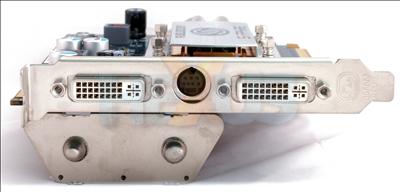Sapphire HD 2600 XT ULTIMATE 256MiB GDDR3 appearance
Take a look at our initial evaluation of the Radeon HD 2600 XT's architecture if you need to know what makes this unified shading GPU tick along merrily with DX10 code.
Before we move on, we need to remind you that AMD's DX10 line-up is something of a mess. The Radeon HD 2600 XT is the highest-performing mid-range part but retails for under £100. The next rung up - and it's a big step - is the recently-announced Radeon HD 2900 Pro, priced from £175.
Still, even with the newest member inducted into the R600-derived family, there's nothing much in the crucial £100-£150 pricing bracket.
Like other Sapphire ULTIMATE models, the HD 2600XT ULTIMATE has completely passive cooling. The front-mounted portion of the heatspreader - where the GPU is located - is deceptively small. Heat is ferried by two heatpipes and around to the larger heatsink on the back.
As you can see, there's no cooling of any kind for the 256MiB RAM chips. What you need to know is that the reference Radeon HD 2600 XT boards are outfitted with either GDDR3 or faster GDDR4 memory. Sapphire uses stock-clocked GDDR3, operating at an effective 1386MHz and interfacing with the card via a 128-bit memory interface. The core speed is a default 796.5MHz, though.
Here's where the aluminium fins help dissipate the heat produced by the GPU. The card can be safely used without any airflow directed at the board but for optimum performance, it's best to have a large, slow-spinning fan pushing cooler air over the fins.
The ULTIMATE supports AMD's CrossFire multi-GPU technology and a couple of these cards can be run in tandem for near-double framerates.
The rear-mounted heatsink is so large that it takes up the slot adjacent to the graphics card. The orientation of the heatsink is such that your motherboard's northbridge heatsink may foul the placement of the card, so take a good look before opting for this product.
You may have noticed that the PCB has no display-related ASICs. The RV630 XT GPU includes the hardware necessary for two dual-link DVI ports - and support for HDCP and audio-routing. Further, as per reference specification, the card features what AMD calls a Unified Video Processor. This uses dedicated silicon to hardware-accelerate video encoded in computationally-expensive VC-1 and H.264 formats.














